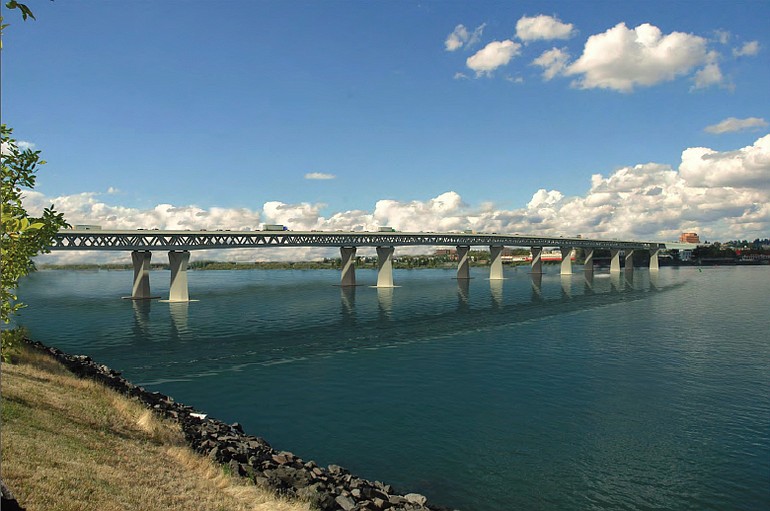State transportation officials will hold two listening sessions on March 10 regarding their proposed recommendation for a composite truss bridge design. The first will be held from noon to 2 p.m. at the Portland Expo Center, Hall D, 2060 N. Marine Drive in Portland. The second will be held from 6 to 8 p.m. at the Washington Department of Transportation, 11018 N.E. 51st Circle in Vancouver. Comments also can be submitted online at columbiarivercrossing.org.
The Columbia River Crossing project proposes to replace the existing twin three-lane drawbridges with 10 lanes over the river, improve five miles of Interstate 5 on both sides and extend Portland’s light-rail transit system into downtown Vancouver.
Click here to see a project timeline, previous stories and other links.
Washington and Oregon transportation leaders are recommending a new Interstate 5 bridge that looks similar to the design rejected this month.
A composite truss design will be cheapest to build and most likely to keep the multibillion-dollar Columbia River Crossing project on schedule, according to the draft recommendation to Govs. Chris Gregoire and John Kitzhaber. State transportation leaders selected the composite truss design over two other alternatives — cable-stayed and tied-arch designs — put forward this month by a panel of bridge experts.
A final recommendation will come in mid-March, after an opportunity for public review.
The composite truss design includes twin spans for northbound and southbound cars and trucks. The southbound span would carry an extension of Portland’s light rail transit system on a lower deck, while the northbound bridge would carry a pedestrian and bicycle path below the traffic deck.
It looks similar to the old design, which had been derided as resembling an aircraft carrier.
The governors agreed with the bridge expert review panel’s recommendation to kill the old open-web box girder design because of its high cost and questionable durability.
The new design uses standard construction techniques and straightens the alignment across the river.
But it’s no thing of beauty, according to the recent expert review.
“It is difficult to present any truss bridge as an architectural solution that would be appropriate for this special crossing of the Columbia River,” the panel concluded in its 144-page report. “Ultimately, the composite deck truss closely resembles the open-web in appearance and form.”
Panel chairman Tom Warne, informed of the selection on Friday afternoon, suggested the composite truss might not be so bad.
“There are architectural treatments that you can include in any bridge which give it a statement that is of interest,” Warne said. “I do appreciate that aesthetics is in the eye of the beholder.”
Each of the three alternatives is cheaper than the old open-web box girder design.
The composite truss is the cheapest.
The Bridge Expert Review Panel estimated the truss design is about $100 million cheaper than the old CRC design, about $50 million less than the cable-stay design and $90 million less than the tied-arch bridge. Planners worry that the taller structures would require Federal Aviation Administration approval to impinge on the airspace of nearby Pearson Field — even though they would be an improvement on the lift spans that stick into Pearson’s airspace on the existing I-5 bridge. The original span, which opened in 1917, predates the existence of the FAA.
All three of the proposed bridge designs include the 95-foot clearance needed to allow river traffic to pass without bridge lifts.
Vancouver city councilors indicated a preference last week for the cable-stayed design.
Even so, at a time of tight budgets and lingering economic distress, Vancouver political leaders expressed no interest in demanding the cable-stayed design — especially if it raises the risk of further delays. As it stands, construction couldn’t start before 2013.
Vancouver Mayor Tim Leavitt said he respects the state agencies’ recommendation.
“It’s another step in the process of moving forward on this project, so that we can start turning dirt,” he said. “The sooner the better, we put people back to work in our region. This project will be a definite shot in the arm.”
Leavitt said a basic flat deck bridge may not provide a postcard-worthy image.
“That’s not to say that some kind of vertical dimensions can be incorporated into the final design that we can be proud of,” he said.
Warne, who consulted on the replacement for the Interstate 35W bridge that collapsed in Minneapolis in 2007, said the new span over the Mississippi River employs the same basic structure as the plain-Jane Interstate 205 bridge across the Columbia. However, he said the Minneapolis span includes a striking white paint job, distinctive pillars and lighting worthy of architectural design awards.
“I believe that you can make the composite deck truss attractive,” Warne said.
Gregoire and Kitzhaber are scheduled to meet Sunday with U.S. Transportation Secretary Ray LaHood while they visit Washington, D.C., for a conference of the National Governors Association. The governors wanted a draft recommendation on a bridge type before pressing LaHood to support the $3.6 billion project.
Erik Robinson: 360-735-4551, or erik.robinson@columbian.com.



